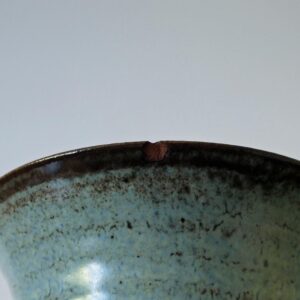Here you will find the terms that appear in connection with kintsugi explained in a glossary. This is because kintsugi comes from Japan, which is why almost all the terms that appear in connection with kintsugi come from Japanese. Basically, the kintsugi glossary is a kind of kintsugi dictionary, because next to each term is an explanation of what that Kintsugi term means.

Photo: Robert Züblin
Kintsugi Glossary
| TERM | EXPLANATION |
|---|---|
| Cashew lacquer | Synthetic phenol-based lacquer for making kintsugi |
| chijimu | Shrink, contract; in the context of urushi work, this refers to the phenomenon of the applied urushi lacquer forming wrinkles as it dries, which can happen as a result of the lacquer being applied too thickly and/or the humidity being too high and/or the lacquer drying too quickly. |
| Furo | Curing box used to allow the Urushi lacquer to cure on the respective object under sufficient humidity and temperature. |
| Gintsugi | Silver lacquer repair, in which a silver powder is sprinkled on the semi-dry urushi lacquer instead of gold powder. |
| hon-urushi/honurushi | Genuine urushi lacquer, raw lacquer, base lacquer |
| Jinoko | Jinoko is a ground powder of burnt diatomaceous earth; compared to Tonoko, Jinoko has a coarser grain size. |
| Jozuri | Topcoat used in the application of graded metals |
| Kinoko | Fine wood flour/fine sawdust |
| Kintsugi | Gold lacquer repair, in which gold powder is sprinkled on the semi-dry urushi lacquer |
| Ki-Urushi/kiurushi | Genuine Urushi lacquer, raw lacquer, base lacquer |
| Kokuso | Compound to restore or replace larger defects (gaps from approx. 3 mm); recipes vary: 1st variant: mugi-urushi, tonoko and wood flour, 2nd variant: mugi-urushi and wood flour, 3rd variant: sabi-urushi and wood flour. |
| Mawata | Silk wadding |
| Mugi-urushi/mugiurushi | Mixture of mugi (wheat flour) and urushi lacquer (lacquer from the lacquer tree) to glue ceramic parts together |
| Muro | Curing box used to allow the Urushi lacquer to cure on the respective object under sufficient humidity and temperature. |
| Roiro-Urushi | Urushi black lacquer, used for black raku pieces and/or for sprinkling with silver powder |
| Sabi Urushi | Mixture of Jinoko or Tonoko, water and Urushi lacquer (lacquer of the lacquer tree) to fill smaller defects (gaps and chips up to approx. 3 mm); first mix water and Jinoko/Tonoko and then mix this mixture with Urushi lacquer, otherwise the mass will not get plasticity. |
| Seshime urushi | Formerly branch lacquer obtained from thin lacquer tree branches; today synonymous with ki-urushi/kiurushi and hon-urushi/honurushi. |
| Shinurushi | Synthetic lacquer for making kintsugi |
| Tonoko | Tonoko is a mass of a clay flour that is very rich in quartz; compared to jinoko, tonoko has a finer grain. |
| Toxicodendron vernicifluum | Lacquer tree (lacquer sumac) from whose resin the Urushi lacquer is made |
| Urushi | Lacquer made from the resin of the lacquer tree (Toxicodendron vernicifluum). |
| urushi-buro | Curing box used to allow the Urushi lacquer to cure on the respective object under sufficient humidity and temperature. |
| urushi-muro | Curing box used to allow the Urushi lacquer to cure on the respective object under sufficient humidity and temperature. |


